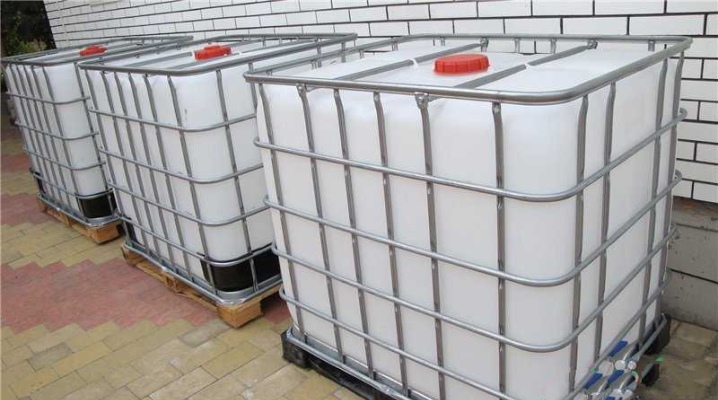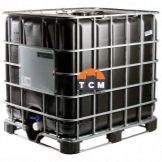Choosing a Eurocube for water

It is very important to choose the correct eurocube for water both for individuals and for the personnel of various companies where such tanks are used. It is necessary to understand the features that a 1000 liter cube and a different volume have, in the main dimensions of plastic cube containers. A separate significant topic is how to connect the Euro tank in the country to the water supply.


What it is?
Eurocube for water is a polymer tank for storing food liquids. Modern polymers are stronger than their early samples and therefore can be used quite widely. The containers obtained on their basis are suitable for both industrial and domestic purposes. Additionally, a special metal crate helps to increase the strength of the products. It closes the structure from the outside along the entire perimeter.
Normal operation in winter is ensured by means of the bottom pallet. Polyethylene is quite reliable and at the same time lightweight, because the structure weighs relatively little. The tank includes a neck part and a protective cover. Handling such products is very simple. The liquid is drained through a flanged valve, the typical cross-section of which (at the outer edges) is approximately 300 mm.
To form a food eurocube, they usually take PE100 grade polyethylene. It makes no sense to use a more expensive variety. By default, the design is white. However, consumers can do their own coloring in any tone (or order an initially painted product).
The use of ball valves alone achieves an excellent level of reliability.



The name IBC is certainly no coincidence. In decoding this English-language abbreviation, the emphasis is on the movement of various fluids. Carrying water in them is almost no harm. Polyethylene has an excellent class of resistance to external influences and tolerates mechanical stress relatively well. Compared to other types of plastic, it has the most attractive characteristics.
Eurocubes are reusable by default. However, if caustic and poisonous substances were previously stored in such containers, it is strictly forbidden to acquire them. The fact is that such reagents can be absorbed into organic material and then washed out with water. Although the danger is sometimes not too high, it is unpredictable, and it is better to refrain from buying problem containers altogether. Conclusion: it is necessary in advance to very carefully find out its origin, and not to buy tanks from dubious firms.

Species overview
Most often, the cubic capacity purchased for industrial purposes is designed for 1000 liters. Larger reservoirs are needed only sporadically, and only for some specific needs. Thousand-liter barrels for summer cottages are used only in isolated cases when a solid supply of water is needed due to interruptions in water supply or its complete absence. All sizes and other characteristics of euro tanks are clearly standardized, and even if they are not directly indicated in the standard, manufacturers are always obliged to indicate the general parameters directly on the manufactured container. Capacity for 1000 l:
-
in length reaches 1190-1210 mm;
-
in width is 990-1010 mm;
-
in height it is equal to 1150-1170 mm;
-
may exceed the declared volume up to 50 liters (which is quite acceptable for this type of product);
-
weighs from 43 to 63 kg.


The container material is folded in 2-6 layers. It is important that we are always talking about low pressure polyethylene (or, as professionals say, high density). In foreign labeling and foreign technical literature, it is denoted by the abbreviation HDPE. The default wall thickness ranges from 1.5 to 2 mm. The thicker the plastic tank, of course, the greater its weight with the same volume. Sometimes the difference reaches tens of kilograms, so this circumstance should not be neglected.
The difference may relate to the execution of the pallet:
-
made of wood (with special heat treatment);
-
made of solid plastic (with steel reinforcement);
-
mixed (steel and plastic);
-
pure steel container.




The completeness of the delivery of the Eurocube is also important:
-
drain taps;
-
sealing gaskets;
-
covers;
-
branded adapters.

Additionally, Euro tanks are distinguished by:
-
degree of protection against ultraviolet radiation;
-
the presence of antistatic protection;
-
using a gas barrier;
-
the size of the filler neck;
-
internal color of the tank;
-
the size of the pouring valve;
-
the presence of overpressure valves in the cover;
-
type of lathing (if any).


A food euro cube with a volume of 500 liters is usually 70 cm wide. With a depth of 153 cm, the typical height of this product is 81 cm. The neck section is most often 35 cm. Basically, such containers have a horizontal working position, but there are exceptions - such a point should be discussed. In most cases, the storage temperature of Eurocubes (not the temperature of use!) Is from –20 to +70 degrees.
The WERIT euro tank also deserves attention, the main parameters of which are:
-
capacity 600 l;
-
pouring valve of plunger type DN80;
-
three-inch thrust thread;
-
six-inch bay neck;
-
plastic pallet;
-
lathing based on galvanized steel;
-
size 80x120x101.3 cm;
-
weight 47 kg.

How can a cube be used?
Using a euro tank at the dacha for drinking water is not the only possible solution. Initially, such containers were designed for use in the industrial sector. Therefore, you can completely safely store fuel and lubricants, vinegar, and vegetable oil in them. True, it must be borne in mind that the stored substances will gradually be eaten into the reservoir. Therefore, you should immediately highlight the purpose of the container, and not violate it.
And yet, in most cases, such tanks are bought specifically for water. In this case, the used tanks are carefully washed. Sometimes, washing is consumed several times more water than can be contained in the tank. We are talking about those cases, of course, when it is planned to use liquid for drinking or irrigation needs.
Large surface-mounted tanks are usually installed with a foundation.


This path is quite reliable and meets even the most stringent technical requirements. Some summer residents, gardeners and even just owners of private houses take 2 euro cubes to collect rainwater. When precipitation falls, drops rush exactly into these containers. Of course, even a special net will not allow you to use water for drinking. However, it is quite possible to satisfy ancillary auxiliary needs.
We are talking about:
-
washing a car (motorcycle, bicycle);
-
washing floors;
-
replenishment of the sewage system;
-
watering garden, garden and indoor plants;
-
preparation of building mixtures.


Usually 1 sq. m of the roof surface, 1 liter of precipitation falls out (in terms of 1 mm of rain water column). With a heavy downpour, of course, the filling will occur even more intensively. The withdrawal of liquid to the garden is usually done through the drain taps located in the lower parts of the euro cubes. However, the installation of such a container and its connection to water supply networks is sometimes necessary for other reasons. For example, for organizing a shower, which is very important in the country and in a country summer house.
In this case, a special steel frame is used, or the pillars and the lattice are welded from above together. If you put a 1000 liter tank, you can safely use one refueling for 20-30 days, especially without limiting yourself.
Recommendation: it is worth covering the tank with a dark paint (not necessarily black); then the water will be heated faster. Another Eurocube allows you to organize a bath (or a hot tub - as you like to say). They simply cut off the top of the container, prepare the flow and drain of water.
Do not leave the bars of the grill open. The frame is usually sheathed with PVC clapboard.


However, there is another option - the organization of a septic tank. Most often, 2 tanks are used, and the 3rd is really needed only with a large number of people using the dacha.
A good septic tank should have:
-
input channel;
-
discharge channel;
-
ventilation outlet.
Any openings are thoroughly sealed in advance. The perimeter of the tanks must be insulated with foam and reinforced with concrete. Septic tanks are filled with water in advance so that they do not deform.

But the Eurocube can also become a good base for storing fertilizers or for composting them. The top of the container is only cut off; chemical neutrality of polyethylene allows you to safely add various fertilizers there.
Alternative solutions include:
-
garbage storage;
-
organization of drinking bowls for livestock;
-
feed accumulation;
-
aquaponics;
-
water reserve in case of emergency (in this case, it is more correct to connect the container to the water supply system and accumulate liquid there, periodically updating it).















The comment was sent successfully.